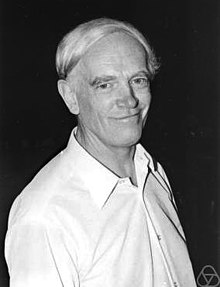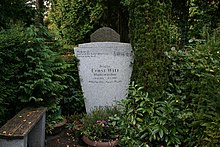Ernst Witt

Ernst Witt (born June 26, 1911 in Alsen , German Empire , today Denmark , † July 3, 1991 in Hamburg ) was a German mathematician.
Life
Witt was born on the island of Alsen, which belonged to Prussia until 1920. His father Heinrich (1871–1959) had been a missionary for the Liebenzeller Mission in China since 1900 , and Witt was born from 1911 to 1913 during his father's home leave. His mother Charlotte Jepsen came from Sønderborg on Alsen. Shortly after his birth, he moved with his parents to China , where his father led the Liebenzeller Mission in Changsha . Witt learned Mandarin there from his nanny. He only returned from China to Germany at the age of nine, where he lived with his brother with an uncle in Müllheim . After his school education in Müllheim and the Abitur in Freiburg im Breisgau in 1929 , he studied at the Albert-Ludwigs-Universität Freiburg and from 1930 at the Georg-August-Universität Göttingen , where he studied with Gustav Herglotz in 1934 with a topic proposed by Emmy Noether , Riemann -Roch's theorem and Z-function in hypercomplexes , PhD. In it he transferred the Riemann-Roch theorem to algebras over fields of functions. Emmy Noether was already suspended at that time, so that he did his doctorate with Herglotz, but she continued to hold a seminar at her home that Witt also attended. He also heard from Emil Artin in 1932, when he was giving guest lectures on class field theory in Göttingen and, at the invitation of Artin, in Hamburg, where he transferred class field theory to function fields. In Göttingen he later belonged to the working group around the algebraic scientist Helmut Hasse , whose assistant he was from 1934 and with whom he completed his habilitation in 1936. Witt was a lecturer at the University of Hamburg from 1938 , where he stayed until his retirement in 1979. In 1939 he became an associate professor there and in 1954 a full professor, interrupted for two years from 1945 due to the denazification process at the British occupation authorities, during which he was fully rehabilitated in 1947. Witt led his own seminar in Hamburg with Max Deuring and from 1951 with Hasse. In the 1940s he also had offers to teach at the Humboldt University in Berlin , where Hasse was also, and gave lectures there. In addition, in the 1950s he was a visiting professor in Barcelona, Madrid (for which he learned Spanish) and Rome (with Francesco Severi ) (partly through the mediation of Wilhelm Blaschke , who tried to reestablish international contacts for the Hamburg mathematicians ). From the beginning of the 1950s, he and his students also received the beginnings of the Bourbaki movement, which was spreading out of France at the time , and which particularly suited his mathematical style.
His doctoral students include Kay Wingberg , Ina Kersten , Walter Borho , Günter Harder , Bernhard Banaschewski , Jürgen Rohlfs , Manfred Knebusch and Sigrid Böge .
He had been married to the mathematician Erna Bannow since 1940 , also a student of Emil Artin , who did her doctorate under Witt in Hamburg in 1939 (The Automorphism Group of Cayley Numbers). With her he had two daughters.
Ernst Witt's grave is in the Nienstedten cemetery in Hamburg.
Witt in the time of National Socialism
During the time of National Socialism , Witt was a member of the SA from 1933 , which, according to Richard Courant , caused irritation among himself and other Göttingen mathematics professors. Courant (as long as he could remain in Göttingen himself) sponsored Witt, who had great financial difficulties to complete his studies and had to limit himself very much. However, as Erich Hecke and others (known for his opposition to the National Socialists in Hamburg) testified in the denazification process, Witt's attitude was not anti-Semitic. Rather, it was characterized as “unworldly” and apolitical, with an almost complete focus on mathematics. He was not involved in the riots by National Socialist students and his friend Oswald Teichmüller at Göttingen University. It is unclear whether it was himself or his friend Teichmüller who was in SA uniform in Emmy Noether's seminar (which she held at her home in 1933). Emmy Noether preferred not to take any public notice of it and continued to teach her seminar, supervised Witt as a doctoral student and ensured that Herglotz continued to supervise Witt's doctoral thesis after her release .
In his own words, Witt joined the SA because he saw this as a national duty as a German abroad, took part in the SA baggage marches at night, but avoided meetings of his comrades and turned away from the National Socialists when he perceived them as disinterested in scientific questions. When the National Socialist students in Göttingen in 1934 favored a scientifically insignificant candidate as head of the Göttingen Mathematical Institute, he spoke out against it. In 1938 he resigned from the SA and was not a member of the NS student union or the NS lecturer union. In an assessment by the National Socialist Lecturer Association from 1937, he was judged to be calm and reserved, sincere and straightforward, but also eccentric and naive and politically indifferent, and his leadership qualities were denied. During the war he was briefly deployed as a telecommunications operator on the Eastern Front in 1941, but fell ill and after convalescence did not return to the front, where his unit had since been wiped out, but worked in Berlin in the encryption department of the Wehrmacht High Command , where among other things he developed optical machine processes. Witt solved a complicated encryption system of the Polish government-in-exile in London in 1943, using a special mechanical device, the "number worm reducer", which in jargon was half-jokingly referred to as the "Wittskiste".
plant
Witt's work was mainly concerned with quadratic forms and various related fields such as algebraic function fields . He also worked out a classification of Liescher algebras on a geometric basis. In 1938 he described Witt's block plans named after him , the existence of which had already been published in 1931 by Robert Daniel Carmichael . He realized that the automorphism groups of these and derived block diagrams are the simple math groups . Witt is said to have found some new finite simple groups in his investigation of Mathieu groups, but did not publish them. In the 1950s he also planned a book about Lie groups in the basic teaching series by Springer Verlag, but nothing came of it. His work is characterized by clarity and brevity. He also dealt with intuitionist logic in the 1940s and 1950s.

The Witt vectors , infinite sequences of elements of a commutative ring , are named after him . Witt constructed a ring structure on the set of such vectors in such a way that the ring of Witt vectors over a finite field of order corresponds to the ring of p-adic numbers . In his habilitation on quadratic forms in arbitrary bodies, he introduced Witt rings and Witt groups named after him . According to him, Henri Poincaré and Garrett Birkhoff is set of Poincaré-Birkhoff-Witt named on universal enveloping algebras of Lie algebras.
See also
Publications
- Collected Papers. Edited by Ina Kersten , Springer Verlag 1998, ISBN 3-540-57061-6 .
literature
- Ina Kersten: Witt . In: Annual Report of the German Mathematicians Association , Volume 95, Issue 4, 1993, pp. 166–180.
- Ina Kersten: Biography of Ernst Witt . In: Eva Bayer-Fluckiger, David Lewis, Andrew Ranicki (Eds.): Quadratic forms and their applications . American Mathematical Society, 2000, pp. 155-172.
Web links
- Ernst Witt in the Mathematics Genealogy Project (English)
- Literature by and about Ernst Witt in the catalog of the German National Library
- John J. O'Connor, Edmund F. Robertson : Ernst Witt. In: MacTutor History of Mathematics archive .
References and comments
- ^ Math. Annalen , 1934
- ↑ He remained friends with Herglotz until his death
- ↑ So Andreas Speiser , Ina Kersten in Bayer-Fluckiger a. a. (Ed.): Quadratic forms and applications . In: AMS , 2000, p. 164. Erich Hecke's assessment can be found on p. 158f.
- ↑ Ina Kersten in Bayer-Fluckiger a. a. (Editor) Quadratic forms and applications , AMS, 2000. It reproduces the various statements in the denazification process and Witt's own statement.
- ↑ Teichmüller once asked Witt for advice whether he could mention the Jewish mathematician Abraham Adrian Albert in a work , which Witt advocated. Kersten in Bayer-Fluckiger p. 159
- ↑ According to Schappacher (letter in Mathematical Intelligencer 1996) it was very likely he himself. This is also discussed in Kersten, ibid. P. 158 confirmed.
- ↑ Kersten in Bayer-Fluckiger, p. 158. Tent Emmy Noether , AK Peters, p. 147
- ↑ Kersten in Bayer-Fluckiger, p. 164
- ↑ Kersten in Bayer-Fluckiger, p. 160
- ↑ Frode Weierud and Sandy Zabell : German mathematicians and cryptology in WWII. Cryptologia, doi: 10.1080 / 01611194.2019.1600076 , pp. 9-10.
- ↑ According to Otto Leiberich due to Erich Hüttenhain's efforts to save talented mathematicians from the front line
- ^ Bauer: Decrypted Secrets . Springer, 2007, pp. 354, 372
- ↑ Christos Triantafyllopoulos, Polish Stencil codes and secret agent `` Knopf '', 2011
- ↑ TICOM : Detailed Interrogations of Dr. Hut grove . TICOM / I-31, 1945.
- ↑ Frode Weierud and Sandy Zabell: German mathematicians and cryptology in WWII. Cryptologia, doi: 10.1080 / 01611194.2019.1600076 , p. 10.
- ^ Ernst Witt: The 5-subject transitive groups by Mathieu . In: Abh. Math. Sem. Univ. Hamburg . tape 12 , 1938, pp. 256-264 , doi : 10.1007 / BF02948947 .
- ^ Robert Daniel Carmichael: Tactical Configurations of Rank Two . In: American Journal of Mathematics . tape 53 , 1931, pp. 217-240 , JSTOR : 2370885 .
| personal data | |
|---|---|
| SURNAME | Witt, Ernst |
| BRIEF DESCRIPTION | German mathematician |
| DATE OF BIRTH | June 26, 1911 |
| PLACE OF BIRTH | on Als , now Denmark |
| DATE OF DEATH | 3rd July 1991 |
| Place of death | Hamburg |



